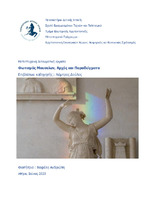| dc.contributor.advisor | Doulos, Lambros | |
| dc.contributor.author | Ανδριώτη, Nεφέλη | |
| dc.date.accessioned | 2023-11-29T07:29:45Z | |
| dc.date.available | 2023-11-29T07:29:45Z | |
| dc.date.issued | 2023-07-04 | |
| dc.identifier.uri | https://polynoe.lib.uniwa.gr/xmlui/handle/11400/5691 | |
| dc.identifier.uri | http://dx.doi.org/10.26265/polynoe-5528 | |
| dc.description.abstract | Τα κτίρια μουσείων συνιστούν σημαντικά τοπόσημα της πόλης, καθώς αποτελούν τόπους με κοινωνικό, εκπαιδευτικό και πολιτισμικό χαρακτήρα. Ο σχεδιασμός του φωτισμού ενός μουσείου, διαδραματίζει σημαντικό ρόλο στη διαμόρφωση της μουσειακής ατμόσφαιρας, συμβάλλοντας παράλληλα στην ανάδειξη των εκθεμάτων και στην αλληλεπίδρασή τους με το κοινό.
Η διαδικασία σχεδιασμού μιας εγκατάστασης μουσειακού φωτισμού είναι μια σύνθετη πρακτική, που απαιτεί ιδιαίτερη προσοχή και διεξοδική μελέτη. Με γνώμονα τις τεχνικές οδηγίες Διεθνών και Ευρωπαϊκών οργανισμών και λαμβάνοντας υπόψιν τα όρια για την προστασία των διαφορετικών εκθεμάτων, ο μελετητής οφείλει να εξετάζει τις τεχνικές και ψυχολογικές παραμέτρους που διέπουν το φωτισμό, τόσο για τη βέλτιστη ανάδειξη των έργων όσο και για τη διατήρησή τους για τις επόμενες γενιές. Ο φυσικός και τεχνητός φωτισμός συνιστούν βασικά εργαλεία της μουσειολογικής αφήγησης αλλά και της ομαλής λειτουργίας του εκθεσιακού χώρου. Η επίτευξη των συνθηκών οπτικής άνεσης, η υιοθέτηση μεθόδων ελέγχου του φωτός και η επιλογή κατάλληλων φωτιστικών σωμάτων και πηγών, συγκροτούν τα βασικά στοιχεία μιας πετυχημένης εκθεσιακής φωτιστικής εγκατάστασης.
Σκοπός της εργασίας είναι η μελέτη όλων των στοιχείων που συνθέτουν μια ολοκληρωμένη στρατηγική εκθεσιακού φωτισμού. Μέσω της παράθεσης σχετικών παραδειγμάτων επιχειρείται μια περαιτέρω διερεύνηση των εργαλείων φωτισμού, και του τρόπου που αυτά αλληλοεπιδρούν μεταξύ τους και συνθέτουν την εκθεσιακή ατμόσφαιρα. Η ανάλυση της περίπτωσης του Μουσείου της Ακρόπολης ως ένα πετυχημένο παράδειγμα μουσειακού φωτισμού, αποτελεί μια προσπάθεια για αναγνώριση και βαθύτερη κατανόηση των κανόνων και των πρακτικών του μουσειακού φωτισμού. Η πρόταση φωτισμού των εκθεσιακών χώρων του Μουσείου Νεότερου Ελληνικού Πολιτισμού συνιστά το τελικό στάδιο της εργασίας, και είναι μια προσπάθεια εφαρμογής των εργαλείων και των τεχνικών του μουσειακού φωτισμού που αναλύθηκαν. | el |
| dc.format.extent | 239 | el |
| dc.language.iso | el | el |
| dc.publisher | Πανεπιστήμιο Δυτικής Αττικής | el |
| dc.rights | Αναφορά Δημιουργού - Μη Εμπορική Χρήση - Παρόμοια Διανομή 4.0 Διεθνές | * |
| dc.rights | Attribution-NonCommercial-NoDerivatives 4.0 Διεθνές | * |
| dc.rights.uri | http://creativecommons.org/licenses/by-nc-nd/4.0/ | * |
| dc.subject | Μουσειακός φωτισμός | el |
| dc.subject | Φωτισμός προθηκών | el |
| dc.subject | Φυσικός φωτισμός | el |
| dc.subject | Τεχνητός φωτισμός | el |
| dc.subject | Σενάριο φωτισμού | el |
| dc.subject | Φθορά εκθεμάτων | el |
| dc.subject | Κανόνες φωτισμού | el |
| dc.subject | Μουσείο Ακρόπολης | el |
| dc.subject | Μουσείο Νεότερου Ελληνικού Πολιτισμού | el |
| dc.title | Φωτισμός Μουσείων, αρχές και παραδείγματα | el |
| dc.title.alternative | Museum lighting design, principles and concepts | el |
| dc.type | Μεταπτυχιακή διπλωματική εργασία | el |
| dc.contributor.committee | Sinou, Maria | |
| dc.contributor.committee | Κλωνιζάκης, Αριστείδης | |
| dc.contributor.faculty | Σχολή Εφαρμοσμένων Τεχνών & Πολιτισμού | el |
| dc.contributor.department | Τμήμα Εσωτερικής Αρχιτεκτονικής | el |
| dc.contributor.master | Αρχιτεκτονική Εσωτερικών Χώρων: Αειφορικός και Κοινωνικός Σχεδιασμός | el |
| dc.description.abstracttranslated | Museums are important landmarks of the city, and they have social, educational and cultural character. The lighting design of a museum plays an important role in creating the atmosphere of the exhibition space, while contributing to the highlighting of the exhibits and their interaction with the public.
The process of designing a lighting installation for museums is a complex practice, and it requires special attention and careful study. Guided by the technical instructions of International and European organizations and taking into account the permissible exposure limits for the protection of the different exhibits, the researcher must examine the technical and psychological parameters that rules the light, to achieve the optimal display of the artworks and their preservation for future generations. Natural and artificial lighting are not only essential tools for the museological storytelling but also enhances the operational efficiency of the museum. The basic elements of a successful lighting installation are the achievement of the visual comfort, the application of light control methods and the selection of the suitable lighting sources.
The purpose of this thesis is to analyze all the elements that consist of an integrated exhibition lighting strategy through the citation of relevant examples. In this manner a further investigation of the lighting tools is attempted, as well as the way they interact with each other and compose the spatial experience of the exhibition. The case study of the Acropolis Museum as a successful example of museum lighting, is an attempt to identify and gain a deeper understanding of the rules and practices of museum lighting. The lighting proposal for the exhibition spaces of the Museum of Modern Greek Culture constitutes the final chapter of the thesis and is an attempt to apply the tools and techniques of museum lighting that were analyzed. | el |


